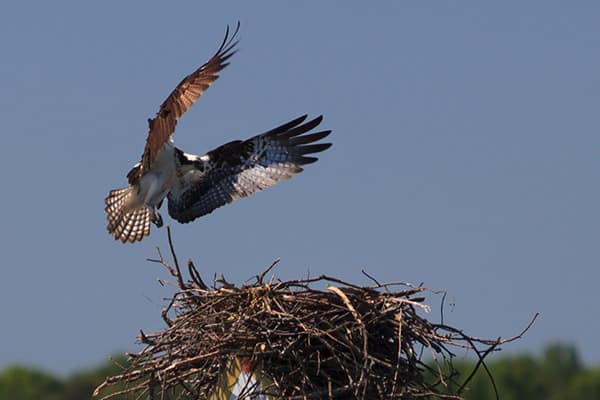Have you ever seen an osprey “sky-dance”?

Ospreys are found on every continent except Antarctica, primarily located along the coasts and large inland lakes in North America. The osprey is a large hawk with white undersides and a crook in its narrow wings. Adults are dark brown above with brownish-black marks on the wings and brown speckling on the breast. The osprey’s head is white with a dark brown crown and brown streak down the cheek. Female ospreys are typically larger than males. At 18 months, they achieve their full adult plumage.
Female ospreys lay one to four eggs in the spring in a large nest made of mostly sticks. Ospreys construct their nests on top of dead trees, power poles, man-made platforms and sometimes on buoys, chimneys or other structures. The nests are used for multiple years, growing up to 10 feet high of nesting materials added each breeding season. The female incubates the eggs for a month, all the while fiercely protecting the nest with her mate. During this time, males will defend the nest and hunt, bringing food back to the nest for their partner. To ward off other osprey, the male will perform a “sky dance” or “fish flight” by clasping a fish or nesting material in his talons and making slow, shallow swoops above the nest site. After sustaining this display for several minutes, he utters repeated screaming calls while gradually descending to the nest.

Sixty days after hatching, young osprey make their first flight! After fledging, the young remain with their parents for almost two months and then remain at wintering grounds for 2-3 years until they return north to make their first attempt at breeding. Ospreys make their first migration alone, instinctively knowing where to go without following their parents.
These large winged birds are the only hawk on the continent that feed exclusively on live fish, which they can catch from the water by using their long, hooked talons. Occasionally, they will catch and eat a snake, eel or a frog. Have you spotted one of these large winged birds snatching dinner from a nearby river or performing its impressive aerial “sky dance”?
Source:
https://www.fws.gov/uploadedFiles/Region_5/NWRS/Central_Zone/Montezuma/OspreyFacts.pdf
https://www.allaboutbirds.org/guide/Osprey/lifehistory
https://www.ncwildlife.org/Learning/Species/Birds/Osprey
https://www.carolinabirdclub.org/gallery/Kerschner/ospr_2.html
NC Wildlife Federation (Image)
